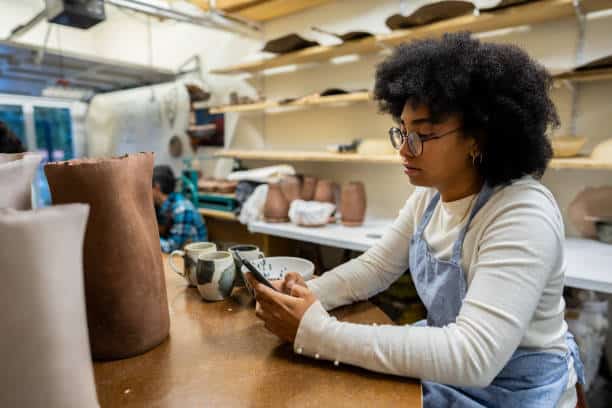Art has evolved beyond galleries and exhibitions; the digital age now offers a unique opportunity for artists to turn their creative passion into a thriving online business. With a global audience at your fingertips, selling art online can be a rewarding and profitable venture. However, success requires more than just talent – it involves strategy, persistence, and the right platforms. In this guide, we’ll walk you through the steps to make money selling art online, from building your brand to maximizing your income.
1. Find Your Artistic Niche

The art world is vast and diverse, and so is the online market. To stand out, you need to find your niche—something that resonates with a specific audience. Consider the type of art that excites you most and the audience you want to reach. Your niche could be abstract art, illustrations, portraiture, digital art, or even handcrafted items.
Questions to Ask:
- What style of art do I enjoy creating the most?
- Who is my ideal audience (e.g., collectors, casual buyers, businesses)?
- What are the current trends in the art market, and how can I align my work with them?

Once you’ve identified your niche, stick to it and develop your unique artistic voice. This helps build a recognizable brand and encourages repeat buyers.
2. Build a Professional Online Portfolio

Having a strong online presence is crucial for selling art online. Your portfolio is your digital gallery and the first impression potential buyers will have of your work. Invest time in curating a professional and visually appealing portfolio.
Steps for Creating a Portfolio:
- Choose a Platform: Opt for a website builder designed for creatives, such as Squarespace, Wix, or WordPress. These platforms offer customizable templates, making it easy to showcase your work.
- High-Quality Images: Ensure your artwork is represented with high-resolution images. Invest in a good camera or hire a photographer to capture your pieces accurately.
- Organize Your Work: Categorize your art by collections or themes to make navigation easier for viewers.
- Include Artist Bio and Contact Info: Share your story, your creative process, and how potential buyers can reach you.
3. Leverage Social Media

Social media platforms are indispensable tools for artists looking to sell online. They allow you to connect directly with your audience, showcase your creative process, and drive traffic to your portfolio or online store.
Best Platforms for Artists:
- Instagram: Instagram is a visual platform perfect for artists. Post regularly, use relevant hashtags, and engage with your followers.
- Pinterest: Use Pinterest to create boards featuring your art and inspiration. Many art lovers use Pinterest to discover and save pieces they like.
- TikTok: If you’re comfortable with video content, TikTok offers massive exposure, especially if you showcase the creation process of your pieces.
Tips for Social Media Success:
- Post consistently and interact with your followers.
- Share behind-the-scenes content, such as your creative process.
- Utilize Instagram and Facebook ads to reach a wider audience.
- Collaborate with other artists or influencers to cross-promote.
4. Choose the Right Online Marketplace

One of the most effective ways to sell your art is by utilizing online marketplaces designed specifically for artists. These platforms have built-in audiences, which means you don’t have to start from scratch to attract buyers.
Popular Marketplaces for Artists:
- Etsy: Best for handmade or vintage art, Etsy is one of the largest platforms for creative entrepreneurs.
- Saatchi Art: A high-end platform where you can sell original artwork or prints.
- Redbubble and Society6: These platforms focus on print-on-demand products. Artists can upload designs, and the platform handles production and shipping, allowing you to sell everything from art prints to t-shirts.
- Artfinder: Offers artists a platform to sell original pieces to art collectors around the world.
Each marketplace has its own fee structure, audience, and marketing tools. Choose one (or several) that align with your style and goals.
5. Pricing Your Artwork

Pricing your art can be one of the trickiest aspects of selling online. Set the price too high, and you may struggle to attract buyers; set it too low, and you undervalue your work.
Tips for Pricing Art:
- Research Comparable Artists: Look at what other artists in your niche are charging for similar pieces.
- Consider Time and Materials: Factor in the cost of materials and the time it took to create each piece.
- Leave Room for Profit: Make sure your pricing covers any fees from online marketplaces and shipping costs, while still leaving a profit margin.
- Start Lower, Then Raise Prices: As your reputation grows and demand for your work increases, you can gradually raise your prices.
6. Master the Art of Marketing
Marketing is essential for getting your art in front of the right people. Beyond social media, there are several strategies you can use to boost your visibility and increase sales.

Email Marketing: Build an email list of interested buyers and collectors. Send regular updates about new artwork, special promotions, or upcoming exhibitions.
SEO Optimization: Optimize your website and portfolio for search engines by using keywords that potential buyers are likely to search for. This can increase your website’s visibility on Google and other search engines.
Collaborations and Partnerships: Partnering with other artists, influencers, or brands can expose your work to new audiences. For example, collaborating with a home décor brand could introduce your art to their customers.

Paid Advertising: Invest in Facebook, Instagram, or Google Ads to target people who are interested in art or your particular niche. This can drive traffic to your site and increase sales.
7. Consider Offering Commissions

Offering custom commissions is an excellent way to diversify your income. Some buyers may want personalized artwork that holds special meaning to them, and they’re often willing to pay a premium for it.
How to Offer Commissions:
- Advertise your availability for commissions on your website and social media.
- Be clear about your process, pricing, and timeline for custom work.
- Create a contract that outlines the expectations for both you and the buyer, including deadlines and payment terms.
8. Diversify Your Income Streams

To maximize your profits, it’s essential to have multiple streams of income. In addition to selling original art, consider expanding your offerings to include prints, merchandise, or digital downloads.
Ways to Diversify:
- Sell Prints: Print-on-demand platforms like Printful or Fine Art America make it easy to sell high-quality prints without the need for inventory.
- Merchandise: Offer your artwork on products like clothing, phone cases, or home décor. Platforms like Redbubble handle the production and shipping for you.
- Licensing: License your work to companies that create products like greeting cards, calendars, or home goods. This allows you to earn royalties without additional effort.
9. Stay Consistent and Adapt

Selling art online is not a get-rich-quick scheme. It requires consistent effort, learning, and adaptation. Stay informed about trends in the art market, and be open to trying new platforms or marketing techniques. Success may not happen overnight, but with persistence, you can build a thriving online art business.
Conclusion
Selling art online offers endless possibilities for artists to reach a global audience and turn their passion into profit. By finding your niche, building a strong online presence, pricing your work effectively, and mastering marketing strategies, you can transform your artistic talent into a sustainable business. The journey requires dedication, but the rewards of creative freedom and financial success make it well worth the effort.




